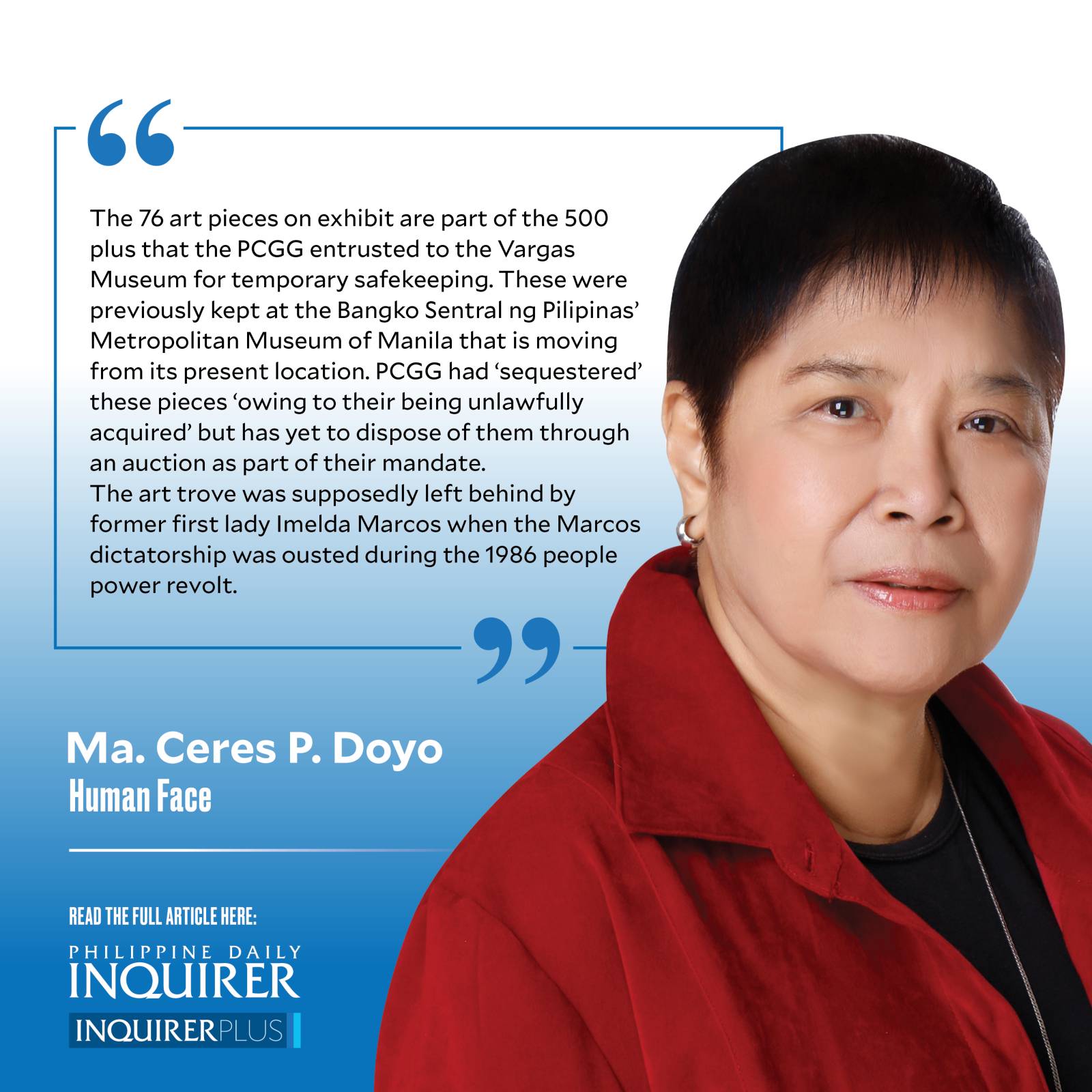Seized ‘Imeldific’ art trove at UP museum

On exhibit at the University of the Philippines’ Vargas Museum are artworks in the possession of the Presidential Commission on Good Government (PCGG). According to museum curator Patrick Flores, the 76 art pieces on exhibit are part of the 500 plus that the PCGG entrusted to the Vargas Museum for temporary safekeeping. These were previously kept at the Bangko Sentral ng Pilipinas’ Metropolitan Museum of Manila that is moving from its present location. PCGG had “sequestered” these pieces “owing to their being unlawfully acquired” but has yet to dispose of them through an auction as part of their mandate.
The art trove was supposedly left behind by former first lady Imelda Marcos when the Marcos dictatorship was ousted during the 1986 people power revolt. From the exhibit notes: “They are entangled in the matrix of refinement and excess, identity, prestige, taste, power and beauty, development, nationalism, and internationalism, acquisitiveness, Cold War, Third World, Martial Law, New Society, People Power.” Pieces in the exhibit “remain under litigation and research on the sequestered property continues.”
The exhibit is dubbed “The PCGG Artworks Collection: Objects of Study.” The piece de resistance hangs on the wall of the landing that leads to the third floor where the collection is. It is huge and dark, titled “Large Landscape with Figure” (approximately 3 meters x 3 meters, oil on canvas, undated) by Italian Giuseppe Zais (1709-1784). This is one of two by Italian masters that remain in the country from the lot of 75 appraised and auctioned by Christie’s in New York in 1991.
The rest are smaller pieces except for the “Altar Piece of Five Saints,” (tempera on wood, undated) by Lippo Memmi (1291-1356) which is quite imposing, I must say. Only Zais and Memmi comprise the Old Italian Masters in the exhibit.
The rest are classified as Russian Lacquerware, Yugoslavian Naifs, and Russian Icons. The Yugoslavian Naifs (all of them acrylic on glass) have a fairytale-like appeal that resonates with one’s childhood imaginations, naif art around which anyone could weave stories. The titles tell tales: “Phantasy Bird Carrying Village,” “The Village in a Basket.” Several of them are dated 1970s. It is “fantasy, folklore and surrealism.” Alas, Yugoslavia is no more.
Eight of the 38 Russian religious icons (17th-, 18th-, 19th-, 20th-century, egg tempera on wood) have the Virgin Mary as subject and given honorific titles derived from places (e.g., “The Virgin of Krasnostock”). As icons go, they have touches of gold and beaten metal on them. Jesus, Mary, saints, prophets, and biblical figures outdo each other on the wall. “St. Luke the Evangelist” held me for more than a moment.
The pieces in the Vargas museum may not be the crème de la crème, but they make me wonder what the rest of the 500 in PCGG’s possession are. But there are so many, many more out there that Imelda Marcos had kept out of sight.
In 2014, I did a two-part series for the Inquirer (“PCGG, Marcos victims in race to claim Imelda art,” 10/12/2014) on the art trove of Mrs. Marcos that are being sought by PCGG agents and the lawyers of more than 6,000 thousand claimants/martial law victims-survivors.
In 1995, a US federal grand jury in Hawaii found the Marcos dictatorship liable for the torture, summary executions, and disappearances of about 10,000 people, and awarded the victims $2 billion in damages from the Marcos estate.
Sadly, the claimants’ lawyer, Robert Swift, said the Philippine courts have refused to recognize the $2 billion judgment while the Philippine government uses its sovereign immunity in the US to try and prevent the members of the class suit from litigating to collect on the judgment, touting the Sandiganbayan decisions forfeiting various Marcos assets in favor of the government as enforceable in the US. It had been a case of finders-keepers. (Swift slipped into the country recently to testify in Makati RTC on behalf of the claimants.)
The second part of my series (“‘Imeldific’ collection of artworks, partial list,” 10/12/2014) listed more than 200 high-value art pieces, among them by Degas, Monet, Gauguin, and Picasso.
The pieces on exhibit at UP’s Vargas Museum could be considered loose change but, when monetized, can go a long way for their supposed beneficiaries—among them, agrarian reform and coconut farmers.
The hunt continues. Was that a Picasso that was photographed somewhere and seen on Facebook?
Read more: https://opinion.inquirer.net/155311/seized-imeldific-art-trove-at-up-museum#ixzz7s2xwOkZK
Follow us: @inquirerdotnet on Twitter | inquirerdotnet on Facebook







